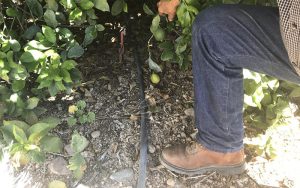PHOENIX – Citrus production, one of Arizona’s founding “Five Cs,” predates statehood. But today, the industry is stuck – and for lemons, the market no longer can grow, thanks to drought and urbanization.
Harold Payne is manager of the 2,000-acre Fort McDowell Tribal Farm, which grows lemon trees on just one-tenth of the land, even though prices have been steadily rising.
“So lemons, they are actually the most profitable because a lemon tree will produce three times as much fruit as a navel (orange) tree,” Payne said. “And the prices are higher. So it doesn’t take a lot of math to figure out, if you have a choice, you’d be growing lemons.”
In addition, people are using more lemons in cooking, seasonings, flavorings and beverages. Worldwide demand for lemons is at an all-time high, but growers in Arizona are not producing more lemons to meet the rising demand.
“The problem is there is no more water,” Payne said. “All of the water is allocated, that is, in the rivers in Arizona. It’s actually overallocated.”
Cities and tribes have the highest priority in water rights. Farmers are last in line, which means a smaller lemon crop on limited land with limited water. Add drought, high heat and natural disasters and prices fluctuate even more, said Harold Edwards, CEO of Limoneira, one of the oldest and largest citrus growers in the U.S.

Harold Payne of Fort McDowell Tribal Farm shows an irrigation line underneath a lemon tree. He would like to grow more lemons, but “The problem is there is no more water.” (Photo by Heather van Blokland/KJZZ)
“And so that’s why you saw the price of lemons rise to very, very high prices toward the end of the summer,” he said, “because of the early season and the early harvest of lemons. Combined with the extreme heat in the latter part of the summer, there just wasn’t enough supply to meet the demand.”
Edwards’ groves in Southern California were damaged this year by high temperatures.
“And the lemons on the tree really had a hard time with that, and the trees had a hard time with that,” he said. “And so you had a lot of fruit that was not able to make it through that heat event and fell onto the ground.”
In early June, the average price of a lemon box was $36. By July, it was $55. By mid-September, $70.
Edwards said consumers “tend to be somewhat inelastic from the standpoint of, if you go to the grocery store and that lemon costs 30 cents or you go that same grocery store and it costs 90 cents, consumers typically buy lemons and don’t typically let that price differential influence their decision.”
There is no alternative for lemons when making things like lemonade or lemon meringue pie. Which prompts some people to take matters into their own hands, said Pamela Hamilton, publisher and editor of Edible Phoenix magazine.
“There are actually some people who go and see a tree that isn’t being used and go knock on a door and ask if it can be foraged,” she said, but other people don’t bother to ask for permission.
“I say (that) as someone whose lemon tree was stripped of lemons while she was on vacation last year,” said Hamilton, who bemoans the decline of agriculture in metro Phoenix.
“In the time that I’ve been here, the amount of farmland that’s been paved over and turned into housing developments is astonishing,” she said. “Any farm that’s still a farm, I’m happy to see that continuing.”
Urban encroachment is another reason the Arizona citrus industry is in decline.
“Because of urbanization, primarily in the Phoenix area, and a number of years of poor returns, the industry has shrunk to about 12,000 acres,” said Glenn Wright, a University of Arizona Extension horticulturist.
“At one point in the ’70s, the Arizona citrus industry – which wasn’t just lemons, it included oranges – was about 80 thousand acres. Quite a lot of it, maybe 40 percent or so in the Phoenix area, and another 60 percent in the Yuma area.”
Arizona lemons now grow on only 15 percent of the acreage they covered in the 1970s. Arizona’s lemon harvest for 2018 is expected to be its lowest in almost a decade, with production declining to less than half of what it was in 2011.
This story is part of Elemental: Covering Sustainability, a new multimedia collaboration between Cronkite News, Arizona PBS, KJZZ, KPCC, Rocky Mountain PBS and PBS SoCal, and part of ongoing Colorado River coverage in partnership with KUNC in Colorado.
Connect with us on Facebook.
